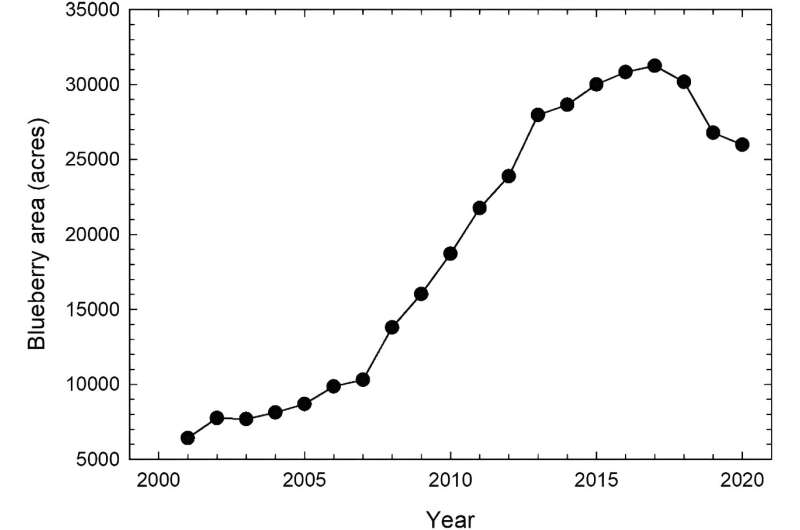This article has been reviewed according to Science X's editorial process and policies. Editors have highlighted the following attributes while ensuring the content's credibility:
fact-checked
trusted source
proofread
Revamping production tactics to control blueberry nursery diseases

The Georgia blueberry industry has experienced significant growth over the past two decades, leading to increased demand for rooted cuttings. This prompted many growers to begin propagating cuttings both for their own use and for sale to other growers. No preferred method has been established for either propagation per se or disease management during propagation.
However, the lack of standardized methods for propagation and disease management has led to wide variations in practices among growers and nursery operators.
A recent study conducted in southern Georgia, U.S., highlights the challenges faced by the blueberry propagation industry. The predominant pathogens are C. ilicicola and Rhizoctonia sp., with water molds (Phytophthora and Pythium species of the Oomycete class) so far contributing little to plant losses from disease.
C. ilicicola is spread primarily through contaminated plant material or propagation substrate, and reuse of propagation media has been strongly linked to Cylindrocladium root rot in rooting beds, underscoring the need for improved disease management practices.
The two surveys revealed a maturation of the blueberry industry over the 15-year interval between them. Indicators of this include the recent leveling-off and slight decline in blueberry acreage, the decrease in producers of propagated plants, and the more uniform propagation methods as compared with 2007.
The 2007 survey gave insights on how growers adapted their propagation systems based on what they observed in neighboring nurseries, but also shed light on the lack of uniformity between them. In contrast, nurseries surveyed in 2022 used similar practices in all but a few aspects.
Since the foundation of any horticultural industry is healthy plants, a streamlined and standardized method of propagation is needed to maintain the viability of the Georgia blueberry industry. Although other factors may be involved as well, propagation research and outreach efforts have been implemented in Georgia over the past ∼15 years, and the industry has generally moved closer to standards that would result in fewer disease problems during propagation.
Propagation in containers and the discarding of used media have become much more prevalent, which helps decrease the spread of disease. Mist head irrigation systems, along with the use of well water, have also seen an increase. Overall, the propagation industry has reached a mature state and is greatly consolidated in the time between the two surveys.
The study highlights several key recommendations for improving propagation practices in the Georgia blueberry industry, including the adoption of container-based propagation systems and the avoidance of media reuse. Additionally, continued research is needed to identify key pathogens associated with cutting failure and to develop optimal chemical control programs.
According to Dr. Brannen, "Whereas many growers are using broad-spectrum fungicides that can control many fungal groups, including water molds (phosphorous acid and mefenoxam) and Rhizoctonia species (azoxystrobin), it must again be mentioned that none of these chemicals are registered for this usage pattern (i.e., for use in blueberry propagation). This is a major concern revealed by this survey."
"As very few chemicals are registered for use in blueberry propagation, much work needs to be done via education of the growers concerning potential threats to their crop and to get chemicals registered for legal use in this industry."
The work is published in the journal HortTechnology.
More information: Jeremy C. Haralson et al, Changes in Production Practices Used for Disease Management in Blueberry Nurseries in Georgia, USA, Over a 15-year Period, HortTechnology (2023). DOI: 10.21273/HORTTECH05154-22
Provided by American Society for Horticultural Science





















